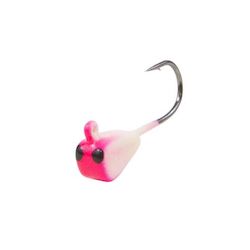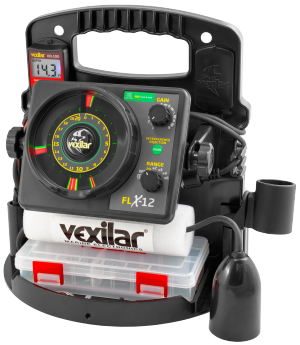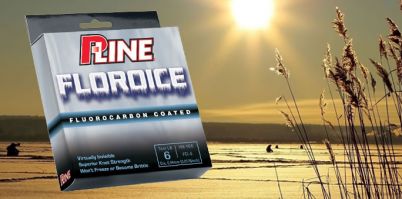News & Stories
Spoon Fed Crappies
Posted by director on January 17, 2020
Spoon Fed Crappies!
By Mike Frisch
It’s no secret that tungsten jigs have certainly found a place in the ice fishing world. Tungsten, which is denser and harder than lead, allows for smaller jig profiles than their lead counterparts weighing the same.
Many panfish have smaller mouths and prefer smaller baits which is one reason to use tungsten. Also, the smaller profile of tungsten makes these jigs less intrusive and, at times, more apt to get bit, particularly in clear water conditions or other times when the bite is tough.
Tungsten has become so popular that I heard a veteran ice angler recently proclaim that “lead is dead” when it comes to winter panfish!
But hold up a second, what about the venerable jigging spoon? Spoons, lures featuring treble hooks, are often made from lead or other heavy metals and are usually larger in profile and fished more aggressively than lead. And, spoons have accounted for lots of winter fish catches, crappies and other fish species too.
Recently, I spent an evening on the ice with veteran lure designer John Crane of Clam Pro Tackle. Our target species was crappies and I expected John would be armed with a full arsenal of miniscule tungsten jigs!
Crane did have a selection of tungsten, but I was somewhat surprised when he suggested we attempt to catch our fish using jigging spoons. “Let’s try some spoons and see if we can’t avoid catching some of those smaller-sized fish and try to get those bigger fish,” was John’s reasoning.
So, we tied on a variety of spoons and tipped them with various baits including waxworms, plastics, and also minnow heads. And, as Crane predicted, the spoons did produce several fish that night including some in the 12-inch size range. At night’s end, I questioned John in greater detail regarding his reasons for selecting spoons as our lures.
“It’s kind of like summer fishing for bass in a tournament when the bite is tough and everybody downsizes and starts fishing finesse baits,” Crane began. “Then, at the weigh in, we find out the winners power-fished with larger lures and caught bigger fish!”
“Bigger baits might not catch as many crappies, but we’re targeting bigger fish and often a larger lure like a spoon creates more of a reaction bite,” Crane went on. “They’re not necessarily eating because they’re hungry, but rather reacting to the spoon.”
We ended up catching fish on several spoons with one of the most productive being the new Jointed Pinhead Mino. This sleek spoon “gets down” quickly in the water column, but it’s two slabs separated at the joint allow for even more fish-attracting movement. And, Crane says, the jointed design also makes this a very versatile bait as well.

“The spoon creates lots of commotion in the water when aggressively jigged for calling in fish and getting aggressive bites,” he commented. “But it they won’t hit it fished aggressively, we can slow down and use very subtle motions to just rock the baited treble hook attached to the bottom slab. Often, even the finicky ones can’t resist that!”
As I thought back on the night, Crane was absolutely right. Monitoring our Vexilar sonars, we “saw” several crappies come in fast and hit. Others, however, would come in fast, but then slow and seem to stare intently at the lure. Slowly raising the spoon and imparting that “rock” to the treble is what was most productive in triggering the finicky fish to bite.
We ended up having a fun night and I regained an appreciation for jigging spoons as crappie baits. If triggering more bites from bigger crappies is on your winter bucket list, consider giving jigging spoons a try on your next ice excursion. Using spoons and the suggestions offered above could very well put a nice catch of “slabs” on the ice for you too!
Mike Frisch is co-host of Fishing of the Midwest TV. View the website: www.fishingthemidwest.com to see more from Fishing the Midwest, including how to enter to win a Vexilar winter sonar unit!
Photo – John Crane with a “spoon fed” crappie!
Factors in Fishing Success!
Posted by director on January 6, 2020
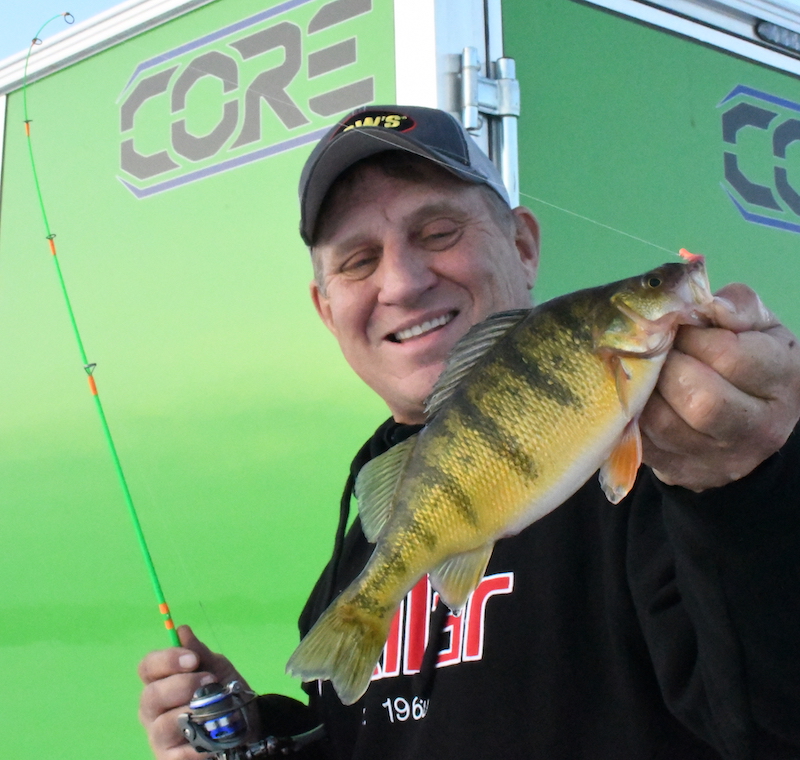 FACTORS IN FISHING SUCCESS
FACTORS IN FISHING SUCCESS
by Bob Jensen
Across much of the Midwest, it’s ice-fishing season. However, across much of the Midwest, we’ve experienced inconsistent weather in the past few weeks, which has led to inconsistent success on the ice. When it comes to ice-fishing or open water fishing, as different as they may seem, weather is a consistent factor in either situation.
Most anglers understand that weather is a major factor in open water fishing, but are surprised to learn that fish under the ice are also affected by weather conditions. It has to do with things that we can’t see, but that the fish can feel, even through a layer of ice. In the summer, when there are several days in a row of warm weather, the fish bite pretty good. The weather is consistent. Then a front goes through. It rains and thunders and there’s lightning. The next day the skies clear, the temperatures drop, and the fish catching really slows down. The weather has the fish in a funk.
The same thing, with some changes, takes place in the winter. Several warm days followed by colder weather seems to damper the fishes hunger: They aren’t interested in eating, but if we present a bait just right, maybe they’ll take it.
Compare the fish in this mood to your mood after you’ve had a big meal. You don’t feel hungry, but you’ll nibble on something if it looks just right. You don’t feel like a whole cheeseburger, but you’ll take a sliver of pie. When a weather front goes through and dampens the fish’s appetite, we need to give them a sliver of pie.
In open water or through the ice, when conditions get tough, we generally need to slow down. In open water, that often means that we need to go to live bait rigs worked slowly, and sometimes live bait below a slip-bobber will be even better.
Through the ice, we’re usually fishing pretty slow anyway, but we need to slow down even more. I’ve experienced situations when hand tremors put too much action on the bait. We had to rest our elbow on our knee to reduce the natural shaking that most people have if we wanted to catch fish. That was extreme, but it was real.
The most important thing to do to increase our odds for success when the fish are skittish is scale down. Go to smaller baits. Genz Drop-Kick jigs tipped with live spikes or waxworms are the way to go.
These jigs look tiny, but they fish big due to the tungsten they’re made of. Sometimes it works well to add just one piece of bait, sometimes several do a better job.
Also experiment with color. When the fish are finicky, a particular color can be the difference between a few bites and no bites. Vexilar sonar units operate in real-time, so you can see fish come in and look at your bait as it’s actually happening.
If they look but don’t eat a couple of times, try a different color jig. Real-time is important. You want to put a different color jig down there while the fish is still in the area.
Last thing: Use a line that is invisible as possible but that you have confidence in. Ice is hard on line, so you want to be sure that, once a fish is hooked, you can get it on top of the ice. 3 pound test Floroice is tough stuff, but it’s also hard for the fish to see.
The catching part of fishing can be more difficult after a weather change, but if you keep these ideas in mind, your chances for success will increase.
* * *
To see the most current and some older episodes of Fishing the Midwest television, fishing articles and fishing videos, and to enter to win a Vexilar depth-finder, go to fishingthemidwest.com
Deep Crappies Provide Mid-winter Fun!
Posted by director on January 3, 2020
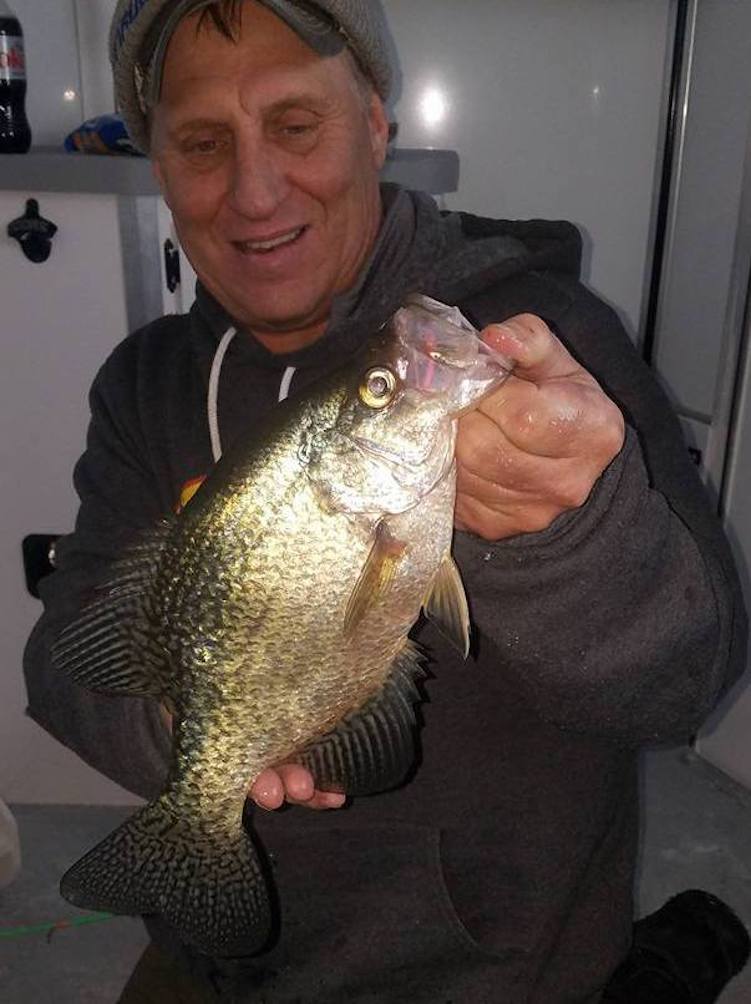 Deep water crappies provide mid-winter action!
Deep water crappies provide mid-winter action!
By Mike Frisch
Mid-winter can be a bit of a difficult time for anglers as the hot bite of early ice, particularly for walleyes, has passed on most bodies of water. Those anglers who shift gears and chase panfish like crappies can, however, often find cooperative fish at this time. Here is a look at some thoughts on ways to find and catch crappies now.
Crappies at this time are often found roaming deep basins searching for food. Basin areas in some of the shallow lakes I fish are often in the 18- to 25- foot depth ranges, some of the deepest water available. Other lakes, with deeper waters, have deeper basins that hold fish.
Winter crappies often roam a particular basin, yet staying in the same general area. For that reason, anglers can often return to productive areas they found in previous winters or on previous trips and drill holes to pinpoint schools.
A key to this process is drilling holes to quickly find those schools. Here is where having a good ice auger is important. The K-Drill auger I use works great for searching basins as it is super lightweight and is powered by a cordless electric drill, so with a charged battery, it’s a reliable starter.
Another important part of basin crappie fishing is the use of a quality flasher sonar unit. Sonar allows me to see bottom, my bait, and any crappies near. “Seeing” fish is especially important as crappies are notorious for suspending in the water column and coming through at various depths. Being able to determine the level the fish are at allows me to quickly put my bait at that level, greatly increasing my odds for success.
I use the FLX-20 Vexilar flasher because it has ¼-inch separation allowing me to easily distinguish my bait and individual fish that often come in several at a time. Plus, this unit is very easy to use as well.
Finding roaming crappies and using sonar when presenting baits are two critical components to success. The last component involves bait and line selection. Small jigging spoons tipped with waxworms or minnow heads are standard fare for catching winter slabs.
Very recently I started using the new Jointed Pinhead Mino spoon for winter crappies. This spoon is available in a small 1/16-ounce size that appeals to crappies, comes in all the right colors, and features a jointed design for a very fish-appealing action that crappies can’t seem to resist.
Spoons are favorite lures for crappies because they often appeal to the bigger fish. Some days when the fish are a bit finicky, however, going with smaller tungsten baits is needed. In this case, a small tungsten jig like a Drop-Kick tipped with either waxworms or small panfish plastics will get the job done.
Tungsten, with its denser than lead property, works great because it sinks quickly to the fish while maintaining a smaller profile the fish will still hit. Tipping the jig with waxworms or small panfish plastics will often yield good results. Pink, red, and white jig and plastic color combinations produce well for me.
Light line and an ultra-light rod/reel combination completes my basin crappie rig. I spool with 3-pound Floroice, a fluorocarbon-coated line that resists freezing and stays limp and manageable even in the coldest conditions.
If finding mid-winter fishing fun is your goal, consider deep-water crappies. By heading to the basin of your favorite panfish lake and employing the tips suggested you can probably get in on some fast winter fishing action. As always, good luck on the ice and remember to include a youngster in your next outdoors adventure!
Mike Frisch is co-host of Fishing of the Midwest TV and a multi-species Minnesota fishing guide, view the website: www.fishingthemidwest.com to see more from Fishing the Midwest.

